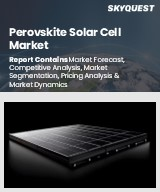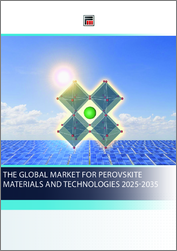
|
시장보고서
상품코드
1461363
페로브스카이트 태양전지 시장 : 현황 분석 및 예측(2023-2030년)Perovskite Solar Cells Market: Current Analysis and Forecast (2023-2030) |
||||||
페로브스카이트 태양전지 시장은 기후변화와 에너지 안보에 대한 우려가 높아지면서 태양광과 같은 재생에너지에 대한 수요가 빠르게 증가함에 따라 예측 기간 동안 48.56%의 강력한 CAGR로 성장할 것으로 예상됩니다. 페로브스카이트 태양전지는 기존의 실리콘 태양전지를 대체할 수 있는 유망한 대안으로 고효율과 저비용을 기대할 수 있습니다. 또한, 페로브스카이트 태양전지의 제조 비용은 기술이 성숙하고 규모의 경제가 달성됨에 따라 향후 몇 년 동안 크게 감소할 것으로 예상됩니다. 이는 페로브스카이트 태양전지가 기존 실리콘 태양전지에 비해 경쟁력이 높아질 것으로 예상됩니다.
구조에 따라 시장은 평면형 페로브스카이트 태양전지와 메조포러스형 페로브스카이트 태양전지로 구분됩니다. 이 중 페로브스카이트 태양전지 시장에서 압도적인 점유율을 차지하고 있는 것은 평면형입니다. 플래너형 태양전지는 메조다공성 태양전지에 비해 필요한 층 수가 적고 공정이 간단하여 제조 비용 효율이 높습니다. 또한, 최근 획기적인 발전으로 평면형 태양전지의 전력 변환 효율이 크게 향상되어 다른 태양전지 기술과의 경쟁력이 높아졌습니다.
제품에 따라 시장은 경질 페로브스카이트 태양전지와 유연 페로브스카이트 태양전지로 구분됩니다. 그 중에서도 유연한 페로브스카이트 태양전지는 가볍고 구부릴 수 있기 때문에 페로브스카이트 태양전지 시장에서 크게 성장하고 있습니다. 이러한 특성으로 인해 기존의 경질 태양전지 패널이 적합하지 않은 다양한 용도에 적합합니다. 또한, 건물 외관과 지붕에 매끄럽게 통합될 수 있으며, 의류 및 기타 웨어러블 기기에 편안하게 통합될 수 있습니다.
제법별로 살펴보면, 시장은 용액 제법, 증착 제법, 증기 보조 용액 제법으로 구분됩니다. 이 중 증착법 부문이 페로브스카이트 태양전지 시장에서 가장 큰 비중을 차지하고 있습니다. 증착 페로브스카이트 막은 스핀 코팅이나 잉크젯 프린팅과 같은 다른 용액 공법으로 제조된 것보다 효율이 높은 것으로 알려져 있기 때문입니다. 이는 증착 공정을 통해 제조된 페로브스카이트 소재의 결정성과 형태가 개선되었기 때문입니다. 또한, 증착 공정은 다른 용액 공정으로 제조된 것보다 가혹한 환경 조건을 견딜 수 있는 보다 안정적인 페로브스카이트 필름을 생성할 수 있습니다.
용도별로 보면 시장은 스마트 유리, 태양광 패널, 페로브스카이트형 탠덤 태양전지, 휴대용 기기, 유틸리티, BIPV(건물일체형 태양광발전)로 구분됩니다. 그 중에서도 태양광 패널 분야는 페로브스카이트 태양전지 시장에서 큰 성장을 이루고 있습니다. 이는 태양광 패널이 페로브스카이트 태양전지의 가장 성숙한 응용 분야로 상용화를 위한 연구개발이 진행되고 있기 때문입니다. 또한, 고효율화 가능성: 페로브스카이트 태양전지는 기존 실리콘 태양전지에 비해 높은 효율을 달성할 수 있어 단위 면적당 발전량을 증가시킬 수 있습니다.
시장은 최종 용도에 따라 제조, 에너지, 산업 자동화, 항공우주, 가전제품으로 구분됩니다. 그 중에서도 에너지 분야는 페로브스카이트 태양전지가 기존 실리콘 태양전지에 비해 제조 비용 절감, 고효율, 유연한 설계 옵션 등 여러 가지 장점을 가지고 있기 때문에 페로브스카이트 태양전지 시장의 성장이 두드러집니다. 또한, 페로브스카이트 태양전지는 낮은 제조 비용과 적은 재료가 필요하기 때문에 기존 실리콘 태양전지보다 탄소 발자국이 훨씬 적습니다.
시장 도입에 대한 이해를 돕기 위해 북미(미국, 캐나다, 기타 북미), 유럽(독일, 영국, 네덜란드, 프랑스, 이탈리아, 스페인, 기타 유럽), 아시아태평양(중국, 일본, 인도, 기타 아시아태평양) 및 기타 세계 각국의 시장 현황을 기반으로 분석되었습니다. 아시아태평양이 페로브스카이트 태양전지 시장에서 우위를 점하고 있는 이유는 이 지역의 급속한 도시화와 경제 성장이 에너지 수요 증가로 이어지고 있기 때문입니다. 또한, 기후 변화와 에너지 안보에 대한 우려는 태양광발전과 같은 재생에너지원에 대한 강력한 추진력이 되고 있습니다. 중국, 일본, 한국과 같은 국가들은 재생에너지 기술의 개발과 보급을 장려하는 지원 정책과 정책을 시행하고 있습니다. 이러한 정책에는 종종 페로브스카이트 태양전지의 연구 개발 및 상용화를 위한 재정적 인센티브와 보조금이 포함되어 있습니다. 또한, 이 지역은 태양광 패널을 포함한 다양한 전자제품의 제조 인프라가 잘 구축되어 있습니다. 이 기존 인프라는 페로브스카이트 태양전지 기술이 상업적으로 성숙해지면 쉽게 생산에 적용될 수 있습니다. 마지막으로, 마이크로콴타 반도체(중국)와 같은 주요 시장 기업이 파일럿 제조 시설을 보유하고 있어 아시아태평양의 우위를 더욱 강화합니다.
이 시장에서 활동하는 주요 기업으로는 Dyenamo AB, Energy Materials Corp, Fraunhofer ISE, Panasonic Holdings Corporation, Frontier Energy Solution, FrontMaterials Co. Ltd., FUJIFILM Wako Pure Chemical Corporation, Toshiba Corporation, G24 Power Ltd, Tandem PV, Inc 등이 있습니다.
목차
제1장 시장 소개
- 시장 정의
- 주요 목표
- 이해관계자
- 제한사항
제2장 조사 방법 또는 가정
- 조사 과정
- 조사 방법
- 응답자 프로파일
제3장 시장 요약
제4장 주요 요약
제5장 세계의 페로브스카이트 태양전지 시장 COVID-19의 영향
제6장 세계의 페로브스카이트 태양전지 시장 매출, 2020-2030년
제7장 구조별 시장 분석
- 평면 페로브스카이트 태양전지
- 메조포러스 페로브스카이트 태양전지
제8장 제품별 시장 분석
- 경질 페로브스카이트 태양전지
- 연질 페로브스카이트 태양전지
제9장 방법별 시장 분석
- 용액 제법
- 증착법
- 증기 어시스트 용액 제법
제10장 용도별 시장 분석
- 스마트 글래스
- 태양전지판
- 텐덤 태양전지 페로브스카이트
- 휴대 기기
- 유틸리티
- BIPV(건물 일체형 태양광발전)
제11장 최종 용도별 시장 분석
- 제조업
- 에너지
- 산업 자동화
- 항공우주
- 가전
제12장 지역별 시장 분석
- 북미
- 미국
- 캐나다
- 기타 북미
- 유럽
- 독일
- 프랑스
- 영국
- 이탈리아
- 스페인
- 기타 유럽
- 아시아태평양
- 중국
- 일본
- 인도
- 기타 아시아태평양
- 세계 기타 지역
제13장 페로브스카이트 태양전지 시장 역학
- 시장 성장 촉진요인
- 시장 과제
- 영향 분석
제14장 페로브스카이트 태양전지 시장 기회
제15장 페로브스카이트 태양전지 시장 동향
제16장 수요와 공급 분석
- 수요측 분석
- 공급측 분석
제17장 밸류체인 분석
제18장 가격 분석
제19장 경쟁 시나리오
- Porter's Five Forces 분석
- 경쟁 상황
제20장 기업 개요
- Dyenamo AB
- Energy Materials Corp
- Fraunhofer ISE
- Panasonic Holdings Corporation
- Frontier Energy Solution,
- FrontMaterials Co. Ltd.,
- FUJIFILM Wako Pure Chemical Corporation
- Toshiba Corporation
- G24 Power Ltd
- Tandem PV, Inc.
제21장 면책사항
ksm 24.05.14Perovskite solar cells are a type of photovoltaic material that has shown great potential as an alternative to traditional silicon-based solar cells. These solar cells are named after the mineral perovskite, which is a calcium titanium oxide. They are relatively lightweight, flexible, and cheap to produce, making them ideal for use in a variety of applications, such as rooftops or buildings. Nowadays, Consumers are increasingly using their smartphones and tablets to access various applications and content on the go. This trend has created a significant opportunity for the automotive industry to integrate these devices into vehicles to provide seamless connectivity and entertainment options.
The Perovskite Solar Cells Market is expected to grow at a strong CAGR of 48.56 % during the forecast period owing to increasing concerns about climate change and energy security, the demand for renewable energy sources like solar power is increasing rapidly. Perovskite solar cells offer a promising alternative to traditional silicon solar cells, with the potential for higher efficiency and lower costs. Additionally, the cost of manufacturing perovskite solar cells is expected to decline significantly in the coming years, as the technology matures and economies of scale are achieved. This will make perovskite solar cells more competitive with traditional silicon solar cells.
Based on structure, the market is segmented into planar perovskite solar cells and mesoporous perovskite solar cells. Amongst these, the segment with the dominating share in the perovskite solar cell market is planar perovskite solar cells because of simpler device design and fabrication techniques. Planar cells require fewer layers and simpler processes compared to mesoporous cells, making them more cost-effective to manufacture. Additionally, recent breakthroughs have significantly improved the power conversion efficiency of planar cells, making them more competitive with other solar cell technologies.
Based on product, the market is segmented into rigid perovskite solar cells and flexible perovskite solar cells. Amongst these, the flexible perovskite solar cells segment has significant growth in the perovskite solar cell market because they are lightweight and bendable. These properties make them suitable for various applications where traditional rigid solar panels are not ideal. Additionally, they can be seamlessly integrated into building facades or roofs and can be comfortably incorporated into clothing or other wearable devices.
Based on method, the market is segmented into solution method, vapor-deposition method, and vapor-assisted solution method. Amongst these, the vapor-deposition method segment has significant share in the perovskite solar cell market because vapor-deposited perovskite films have been shown to have higher efficiency rates than those produced by other solution methods such as spin coating or inkjet printing. This is due to the improved crystallinity and morphology of the perovskite material produced by the vapor-deposition process. Additionally, the vapor-deposition method also results in more stable perovskite films that can withstand harsh environmental conditions better than those made using other solution methods.
Based on application, the market is segmented into smart glass, solar panel, perovskite in tandem solar cells, portable devices, utilities, and BIPV (building-integrated photovoltaics). Amongst these, the solar panel segment has significant growth in the perovskite solar cell market because solar panels are the most mature application for perovskite solar cells, with ongoing research and development efforts towards commercialization. Additionally, potential for higher efficiency: Perovskite solar cells have the potential to achieve higher efficiencies compared to traditional silicon solar cells, leading to increased power generation per unit area.
Based on end use, the market is segmented into manufacturing, energy, industrial automation, aerospace, and consumer electronics. Amongst these, the energy segment has a significant growth in the perovskite solar cell market because it offers several advantages over traditional silicon-based solar cells, including lower manufacturing costs, higher efficiency rates, and flexible design options. Additionally, Perovskite solar cells have a significantly lower carbon footprint than traditional silicon-based solar cells due to their lower manufacturing costs and reduced material requirements.
For a better understanding of the market adoption, the market is analyzed based on its worldwide presence in countries such as North America (U.S., Canada, and the Rest of North America), Europe (Germany, UK, Netherlands, France, Italy, Spain, Rest of Europe), Asia-Pacific (China, Japan, India and Rest of Asia-Pacific), Rest of World. Asia-Pacific region's dominance in the perovskite solar cell market due to rapid urbanization and growing economies in the region lead to increasing energy demand. Additionally, concerns about climate change and energy security drive a strong push towards renewable energy sources like solar power. Countries like China, Japan, and South Korea have implemented supportive policies and regulations encouraging the development and deployment of renewable energy technologies. These policies often include financial incentives and subsidies for research, development, and commercialization of perovskite solar cells. Furthermore, the region boasts a well-established manufacturing infrastructure for various electronics, including solar panels. This existing infrastructure can be readily adapted to produce perovskite solar cells once the technology matures commercially. Finally, The presence of major market players in the region, like Microquanta Semiconductor (China) with its pilot manufacturing facility, further strengthens the Asia-Pacific dominance.
Some major players operating in the market include Dyenamo AB, Energy Materials Corp, Fraunhofer ISE, Panasonic Holdings Corporation, Frontier Energy Solution, FrontMaterials Co. Ltd., FUJIFILM Wako Pure Chemical Corporation, Toshiba Corporation, G24 Power Ltd, and Tandem PV, Inc.
TABLE OF CONTENTS
1.MARKET INTRODUCTION
- 1.1.Market Definitions
- 1.2.Main Objective
- 1.3.Stakeholders
- 1.4.Limitation
2.RESEARCH METHODOLOGY OR ASSUMPTION
- 2.1.Research Process of the Perovskite Solar Cells Market
- 2.2.Research Methodology of the Perovskite Solar Cells Market
- 2.3.Respondent Profile
3.MARKET SYNOPSIS
4.EXECUTIVE SUMMARY
5.GLOBAL PEROVSKITE SOLAR CELLS MARKET COVID-19 IMPACT
6.GLOBAL PEROVSKITE SOLAR CELLS MARKET REVENUE, 2020-2030F
7.MARKET INSIGHTS BY STRUCTURE
- 7.1.Planar Perovskite Solar Cells
- 7.2.Mesoporous Perovskite Solar Cells
8.MARKET INSIGHTS BY PRODUCT
- 8.1.Rigid Perovskite Solar Cells
- 8.2.Flexible Perovskite Solar Cells
9.MARKET INSIGHTS BY METHOD
- 9.1.Solution Method
- 9.2.Vapor-Deposition Method
- 9.3.Vapor-Assisted Solution Method
10.MARKET INSIGHTS BY APPLICATION
- 10.1.Smart Glass
- 10.2.Solar Panel
- 10.3.Perovskite in Tandem Solar Cells
- 10.4.Portable Devices
- 10.5.Utilities
- 10.6.BIPV (Building-Integrated Photovoltaics)
11.MARKET INSIGHTS BY END USE
- 11.1.Manufacturing
- 11.2.Energy
- 11.3.Industrial Automation
- 11.4.Aerospace
- 11.5.Consumer Electronics
12.MARKET INSIGHTS BY REGION
- 12.1.North America
- 12.1.1.U.S.
- 12.1.2.Canada
- 12.1.3.Rest of North America
- 12.2.Europe
- 12.2.1.Germany
- 12.2.2.France
- 12.2.3.UK
- 12.2.4.Italy
- 12.2.5.Spain
- 12.2.6.Rest of Europe
- 12.3.Asia-Pacific
- 12.3.1.China
- 12.3.2.Japan
- 12.3.3.India
- 12.3.4.Rest of APAC
- 12.4.Rest of the World
13.PEROVSKITE SOLAR CELLS MARKET DYNAMICS
- 13.1.Market Drivers
- 13.2.Market Challenges
- 13.3.Impact Analysis
14.PEROVSKITE SOLAR CELLS MARKET OPPORTUNITIES
15.PEROVSKITE SOLAR CELLS MARKET TRENDS
16.DEMAND AND SUPPLY-SIDE ANALYSIS
- 16.1.Demand Side Analysis
- 16.2.Supply Side Analysis
17.VALUE CHAIN ANALYSIS
18.PRICING ANALYSIS
19.COMPETITIVE SCENARIO
- 19.1.Porter's Five Forces Analysis
- 19.2.Competitive Landscape
20.COMPANY PROFILED
- 20.1.Dyenamo AB
- 20.2.Energy Materials Corp
- 20.3.Fraunhofer ISE
- 20.4.Panasonic Holdings Corporation
- 20.5.Frontier Energy Solution,
- 20.6.FrontMaterials Co. Ltd.,
- 20.7.FUJIFILM Wako Pure Chemical Corporation
- 20.8.Toshiba Corporation
- 20.9.G24 Power Ltd
- 20.10.Tandem PV, Inc.



















